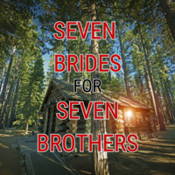
Seven Brides for Seven Brothers
Musical
Writers:Lawrence Kasha David Landay Gene de Paul Joel Hirschhorn Al Kasha Johnny Mercer
Overview
Synopsis
Set in the Oregon Territory during the 1850s, the 2007 stage version of *Seven Brides for Seven Brothers *begins with rugged backwoodsman Adam Pontipee arriving in town to find a wife. He courts the independent and resourceful Milly, who agrees to marry him after a brief but charming courtship. When she arrives at Adam’s remote cabin, Milly is shocked to discover Adam’s six uncouth brothers living in complete disarray. Taking charge, she quickly assumes the role of mentor, determined to instill manners, hygiene, and respect so the brothers can court the town’s young women properly. Her efforts pay off at the barn-raising, where the brothers impress their love interests with new social graces and exuberant dance.
The story takes a chaotic turn when Adam urges his brothers to follow the ancient Roman tale of the “Sabine Women,” leading them to kidnap their sweethearts and bring them back to the farm. Snowfall traps everyone together through the winter, but in this revised 2007 version Milly asserts herself as the voice of morality and strength, ensuring the women are treated with dignity. Over the long winter months, hostility gradually melts into affection, and genuine bonds form between the brothers and their brides. When spring arrives and the townsfolk come to reclaim their daughters, the women confess their love for the Pontipees, leading to forgiveness, reconciliation, and a joyful finale of weddings and newfound community.
Show Information
Context
The 2007 stage version of Seven Brides for Seven Brothers represented a significant re-examination of the material, decades after its original Broadway run in 1982. While the beloved 1954 MGM film remained the foundation, the creative team recognized the need to refine the stage adaptation for contemporary audiences. By 2007, multiple regional productions had experimented with structure and tone, and the London staging incorporated these developments into a streamlined book and revised score.
to read the context for Seven Brides for Seven Brothers and to unlock other amazing theatre resources!Plot
Characters
| Name | Part Size | Gender | Vocal Part |
|---|---|---|---|
|
Lead |
Male |
Baritone |
|
|
Lead |
Female |
Mezzo-Soprano |
|
|
Supporting |
Female |
Mezzo-Soprano |
|
|
Supporting |
Male |
Tenor |
|
|
Supporting |
Male |
Tenor |
|
|
Supporting |
Male |
Tenor |
|
|
Supporting |
Male |
Tenor |
|
|
Supporting |
Male |
Tenor |
|
|
Supporting |
Female |
Alto |
|
|
Supporting |
Female |
Alto |
|
|
Supporting |
Male |
Tenor |
|
|
Supporting |
Female |
Alto |
|
|
Supporting |
Female |
Alto |
|
|
Supporting |
Female |
Alto |
|
|
Featured |
Male |
Baritone |
|
|
Featured |
Male |
Bass |
|
|
Featured |
Female |
Alto |
|
|
Featured |
Female |
Alto |
|
|
Featured |
Male |
Tenor |
|
|
Ensemble |
Male |
|
|
|
Ensemble |
Either Gender |
|
Songs
Act One
Act Two
A song with an asterisk (*) before the title indicates a dance number.
Monologues
Scenes
Key Terms
Counterpoint is a musical technique where two or more independent melodies are combined and performed simultaneously. Each line maintains its own rhythm and contour, yet together they create harmonic richness and complexity. This interplay adds texture, depth, and dynamic contrast to a piece of music.
A group of performers who function as a unit in a production rather than as individuals with leading roles.
A recurring musical theme associated with a particular character, idea, or emotion. Frequently used in opera and musical theatre, leitmotifs help reinforce narrative continuity and emotional cues for the audience.
A dramatic genre with exaggerated characters and emotions, often including music to enhance moral and emotional stakes.
A quartet is a musical or dramatic piece performed by four singers or actors, each contributing a distinct part. The voices or roles are usually balanced so that harmony and interplay between the four performers create a unified effect. Quartets can highlight contrasting perspectives, showcase layered harmonies, or advance the story through multiple viewpoints at once.
Stage combat is the carefully choreographed portrayal of physical conflict on stage, designed to look realistic while ensuring performer safety. It can include punches, slaps, falls, swordplay, or other forms of combat, all rehearsed under strict guidelines. The goal is to enhance dramatic storytelling without causing actual harm to the actors.
Videos
Quizzes
Sorry! We do not currently have quizzes for this guide.
Themes, Symbols & Motifs
Frontier Life and Survival
The musical captures
to read about the themes, symbols and motifs from Seven Brides for Seven Brothers and to unlock other amazing theatre resources!Quote Analysis
Sorry! We do not currently have learning modules for this guide.
